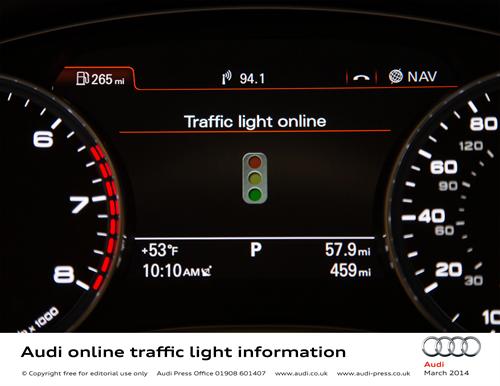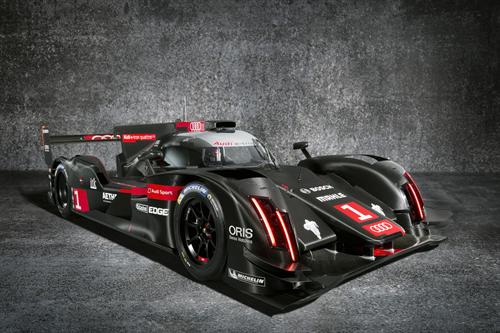
 Market maturity for traffic light networking represents the next phase of Audi connect
Market maturity for traffic light networking represents the next phase of Audi connect
- Audi Online traffic light information system has the potential to save time and fuel
- 15 per cent reduction in CO2 emissions possible
- System alerts driver to speed required to reach the next green light
- Fully developed prototype system showcased in an Audi A6 Saloon at CES
- Integrated into Audi connect and MMI, and compatible with every Audi model
Audi is ready to add a little oil to the wheels of the daily grind with advanced traffic light recognition technology which could make driving through towns and cities far more fluid and free of annoying and economy-denting red light punctuation.
Audi Online traffic light information harnesses the power of in-car internet in a new way via Audi connect to establish a link between the car and the traffic light network via the central traffic computer in each town or city. It quickly assimilates the automated traffic light change sequences in the vicinity, and on the approach to a set of lights the Driver Information System (DIS) located in the central instrument cluster then shows the driver the speed to select in order to pass through the light during a green phase. It also displays a visual aid using red, amber or green icons.
If the driver is already waiting at a red light, Audi connect will calculate and count down the time remaining until the next green light is scheduled to appear via a timer on the DIS. The system also interacts with the car’s Start-Stop function to ensure the engine is switched on five seconds before the green phase.
Audi AG calculates that Online traffic light interaction has the potential to reduce CO2 emissions by up to 15 per cent, and could save approximately 900 million litres of fuel if it were to be deployed throughout Germany.
The fully functional system is now production ready and could be fitted to every Audi model in the range subject to the necessary government legislation. It was actively demonstrated recently on the busy Las Vegas freeways in an Audi A6 Saloon as part of a trailblazing technology display at the Consumer Electronics Show, and comprehensive testing continues in Las Vegas with 50 sets of traffic lights. Testing is also underway in the northern Italian city of Verona, where some 60 traffic lights covering almost the entire city centre are involved, and in Berlin, where 25 Audi customers are driving cars fitted with Online traffic information that can link up to a total of 1,000 traffic lights in the city. A market launch is currently the subject of intense analysis in the United States.
Online traffic light information shared the stage with a host of technological advances from the Vorsprung durch Technik brand at this year’s CES, which represented the next phase in seamless connectivity between Audi models, their drivers and the rest of the digital world. Significant developments in Audi piloted parking and driving were demonstrated, with the central focus on an Audi A7 Sportback that can drive fully autonomously in moving traffic. Another immersive innovation is the Audi Smart Display, an Android-based tablet that allows users to interact with in-car controls yet can also be used as a standalone portable device in the home or on the move.
The Sport quattro laserlight concept also revealed the next generation of Audi lighting. The high-beam laser light unit can illuminate the road by up to 500 metres and will debut on the R18 e-tron quattro sports prototype at Le Mans in June.
AUDI ACHIEVES PIONEERING FEAT WITH E-TRON QUATTRO FOUR-WHEEL DRIVE
- Trendsetter Audi: four-wheel drive also established in LMP1 sport
- New development of e-tron quattro four-wheel drive system for 2014
- 34 years of four-wheel drive expertise in production and motorsport
Ingolstadt, March 10, 2014 – Audi has set another trend in motorsport. After the brand revolutionised rally racing with quattro four-wheel drive in the nineteen-eighties and significantly shaped touring car racing with this system in the nineties, four-wheel drive has been making its way into LMP1 sports prototypes as well. The Audi R18 e-tron quattro now aims to extend ‘Vorsprung durch Technik’ with a system featuring an all-new development.

 In 2012, Audi became the first manufacturer to win the Le Mans 24 Hours and the FIA World Endurance Championship (WEC) with a four-wheel-drive LMP1 sports car. Equipped with the innovative e-tron quattro four-wheel drive, the R18 has won ten WEC rounds to date including the 2012 and 2013 Le Mans 24 Hours plus the WEC World Champion’s titles in the same years. In 2014, for the first time, Audi’s two LMP1 challengers on the manufacturers’ side are also relying on LMP1 sports prototypes with four-wheel drive.
In 2012, Audi became the first manufacturer to win the Le Mans 24 Hours and the FIA World Endurance Championship (WEC) with a four-wheel-drive LMP1 sports car. Equipped with the innovative e-tron quattro four-wheel drive, the R18 has won ten WEC rounds to date including the 2012 and 2013 Le Mans 24 Hours plus the WEC World Champion’s titles in the same years. In 2014, for the first time, Audi’s two LMP1 challengers on the manufacturers’ side are also relying on LMP1 sports prototypes with four-wheel drive.
“Innovations only become pioneering achievements when they’re successfully used and others start to adopt them,” says Head of Audi Motorsport Dr. Wolfgang Ullrich. “Audi, like no other manufacturer, has repeatedly achieved such feats ever since the debut of quattro four-wheel drive in 1980.” In the DTM, as well, Audi was the first team in 1990 to use four-wheel drive in racing, just like in Super Touring Cars, starting in 1993. In the past two years, on achieving the string of success in the WEC, the brand proved that e-tron quattro – the combination of a hybrid system with four-wheel drive – offers significant advantages.
Up to now, Audi had been allowed to use four-wheel drive only above 120 km/h. But four driven wheels promise to deliver traction advantages particularly at low speed, for instance when the driver accelerates on exiting a tight corner. This year, this speed-related rule no longer applies.
A fundamentally new Motor Generator Unit (MGU), together with a differential, sits in the monocoque at the level of the front axle. Two drive shafts connect the system with the front wheels. Under braking, the kinetic energy of the race car is converted into electric current which flows into an optimised flywheel energy storage device located in the cockpit next to the driver. During acceleration, the recovered energy is converted again by the MGU and powers the front wheels.
“We’ve developed the entire hybrid drive from scratch again for 2014,” explains Dr. Martin Mühlmeier, Head of Technology at Audi Sport. “Specifically, it’s become even lighter and more efficient than before.” As of 2014, a single e-machine connected to a front-axle differential is longitudinally mounted. Furthermore, these front-wheel drive components are completely integrated into the monocoque of the R18 e-tron quattro. The recuperated energy is stored in a newly designed flywheel energy storage system.
While the quattro systems of Audi’s factory-fielded rally models and touring cars between 1980 and 1997 used a mechanical connection in the form of a drive shaft between the front and rear axles, the power distribution to the front and rear wheels in the e-tron quattro four-wheel drive system is governed strictly by an electronic control unit. In addition, due to the new efficiency regulations, a modified strategy for the engine and drive system will be used in 2014. The e-tron quattro four-wheel drive with its sophisticated energy flow is characterised by optimum efficiency.
